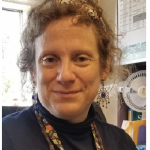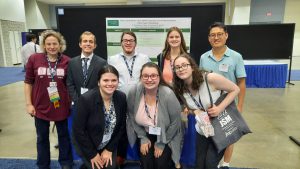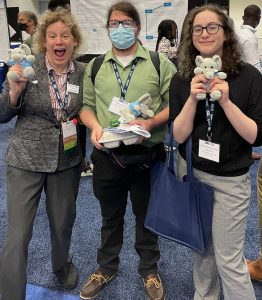 Jana Asher is an associate professor and the director of statistics education at Slippery Rock University.
Jana Asher is an associate professor and the director of statistics education at Slippery Rock University.
Almost four years ago, I interviewed for an academic position at a university in a small, rural town about an hour north of Pittsburgh. The university, itself, was mid-sized—about 8,000 students—and only boasted a few PhD programs in education and health sciences. I interviewed for a mathematics and statistics department, where there were only two statisticians working alongside 10 mathematicians, most of whom had theoretical foci. As a decidedly applied statistician, I wondered how I would fit in.
I had previously taught for two years at Montgomery College in Takoma Park, Maryland, where the students were incredibly diverse in terms of race, ethnicity, socioeconomic status, stage of life, disability status, etc. If there was a category of marginalization, there were students to fill it. I loved the environment and the students.
At Slippery Rock University of Pennsylvania, a school within the Pennsylvania State System of Higher Education and where I was to interview, the students were predominantly from rural, conservative areas of western Pennsylvania, and almost 90 percent of them identified as white.
I went to the job interview and fell in love with the students, environment, and university mission. As a teaching-oriented institution, students come first and research and service second. Research tends to focus on work our predominantly undergraduate population can participate in, and internal grants are available to allow us to pay students for their work. As for those students, a large percentage of them are the first in their families to attend college, and many come from challenging socioeconomic backgrounds.

Front, from left: Alyssa Kasmierski, Rhiannon Helgert, and Rose Resnick; back, from left: faculty member Jana Asher, Elijah McClymonds, Aran Bybee, Alyssa Hilliard, and faculty member Woosuk Kim
At Slippery Rock, I feel I can make a difference in multiple ways—from challenging students’ assumptions to exposing them to new possibilities. Most importantly, many of my students simply don’t believe they are good enough to apply to graduate school, a summer internship program, or an especially interesting job. Mentoring those students—and seeing them succeed—absolutely, unequivocally makes my four-courses-a-semester teaching load worth every hour of tedious grading required.
My statistics colleagues and I also invest a great deal of time providing students with opportunities outside the classroom, from our statistics club to career guidance to the topic of this article. When my colleague Woosuk Kim decided to work with three students to create a poster for this year’s Joint Statistical Meetings, I encouraged several of their classmates to go to the meetings and support them. All together, we shepherded six undergraduate students, and the experiences they had were worth every penny spent.
Faculty members who interact predominantly with graduate students might wonder what an undergraduate student could get out of JSM. Aren’t the talks over their heads? Of course, there are technical talks that won’t appeal to undergraduate students, but there are also talks about statistics education, public policy, JEDI-related issues, and careers in statistics. Every one of my students who attended JSM, including the rising sophomore student, reported finding interesting talks to attend. They also, with our encouragement, attended social events, toured the exhibit hall, and spoke with senior statisticians about the field, their own work, and their aspirations. I am grateful and delighted that every person they interacted with was friendly and welcoming. This is, without question, a convivial environment for undergraduates, where their interest in statistics is appreciated and valued.

From left: Jana Asher, Aran Bybee, and Rose Resnick enjoy their stuffed elephant find at the Cytel booth.
But the most important question is, did the students appreciate and grow from the experience? I don’t think it is an exaggeration to say they loved it. Rising sophomore Rose Resnick says, “I attended JSM with five other undergrads from Slippery Rock University. As the least experienced member of our group, I was intimidated by the Joint Statistical Meetings. How could I understand and communicate with those who had been working in the field for decades? After getting my bearings, I realized I would be accepted no matter my knowledge level, as everyone was excited to see me there and educate me on future internships and other opportunities. There were also talks at the more introductory level on a variety of subjects. Poster presenters were happy to explain their research in a way I could understand.”
Other students were equally happy with their experiences:
I gained so much from attending JSM! I got the opportunity to market myself to possibly some of my future employers…. At JSM, there was something for everyone, whether you are looking for a job, internship, or statistical software package. Also, I got the opportunity to present some of my research that I have been working on throughout the past year. This gave me the chance to present and talk to statisticians about my group’s work, as well as get suggestions for the future! I was happy to see the amount of diversity within statistics that I wish I would get to experience more often. The whole time at JSM, I felt so welcome, and everyone was so inviting. Honestly, I thought as underclassman many would just disregard us, but if anything, they were just more impressed. I was happy to attend JSM and I definitely will be going to Canada next year!
– Alyssa Kasierski, rising senior
Attending JSM has helped me to better network with other people involved in the statistical community. I have had amazing conversations and received extremely helpful advice from people who have been in my shoes. I loved attending the different talks and presentations about diverse aspects and components of statistics. Some of them I had not even considered would use statistics! I especially loved all the opportunities to meet and get to know others during an awesome dance party. Who knew statisticians could groove! I will absolutely be in attendance next year!
– Rhiannon Helgert, rising senior
Attending JSM was such a great experience! The conference offered many opportunities to explore my interests in statistics by attending professional speakers, networking events, and expo booths. Before JSM, I was unsure what career path I wanted to pursue in statistics, but after attending several events and talking with graduate students and professionals in the field, I have a better understanding of what my options and interests are past graduation. Also, I was able to present work from the past year with my research team. This was a great experience because I was able to discuss our work with other statisticians. I was surprised to see how approachable everyone was at JSM, as well. As a result, I met many helpful individuals that were able to motivate me and steer me in the right direction. I am so happy I was able to attend JSM this year, and I am looking forward to attending JSM 2023.
– Elijah McClymonds, rising senior
JSM has given me the opportunity to get advice from many statisticians that took different paths to achieve successful careers. Whether it was advice on things to do early in my career or on getting a PhD, it was all valuable and gave me a different perspective. I also got the chance to talk to many current PhD students, which was nice to hear about their research and experiences. Attending the Caucus for Women in Statistics Reception and Business Meeting was inspiring and empowering. Hearing Dr. Donna Brogan, the founder of the CWS, talk about the obstacles that caused her to create the organization was an experience I won’t forget. It was also nice to hear how much progress has been made to make the field more equally accessible. Overall, attending JSM was a valuable experience that solidified my ambition to be a statistician who contributes to the greater good. Being able to interact and make connections with many esteemed statisticians from all over the world was an experience I will not forget, and I had a lot of fun at all the events!
– Alyssa Hilliard, rising senior
Undergraduate statistics faculty are not just educators; they are the frontline creators of our community. Whether our students end up going into industry, finance, government, nonprofit employment, or graduate school, they are the future of this profession. When we stop thinking about our job as classroom-based and start thinking more holistically about our students, we can see how nurturing all aspects of student development enhances not only their job prospects but also the entire field of statistics. We allow our students and our association to thrive when we involve undergraduate students in professional societies, encourage them to pursue research opportunities and internships off our campuses, bring real data and real societal problems into our classrooms, and encourage their attendance at professional conferences.
#undergradsatJSM … pass it on!



Leave a Reply